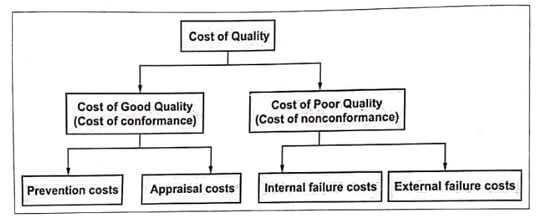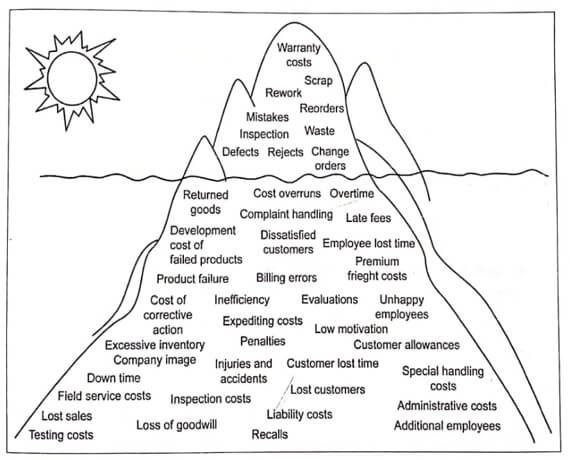COST OF QUALITY (COQ OR QUALITY COSTS)
✓ Cost of quality (COQ) is a financial measure of the quality measure of an organization. It is essentially a measure of lack of quality and can also be termed as cost of poor quality.
✓ The cost of quality isn’t the price of creating a quality product or service. It’s the cost of NOT creating a quality product or service.
✓ Every time work is redone, the cost of quality increases. So the cost of quality refers to any cost that would not have been expended if quality were perfect.
✓ Definition: Quality costs are those incurred in excess of those that would have been incurred if products were built (or service performed) exactly right the first time.
✓ COQ is primarily used to understand, analyze and improve the quality performance. COQ can be used as a standard measure to study an organization’s performance and can be used as a bench marking indices.

Fig. 1. Components of cost of quality
✓ Components of cost of quality: The cost of quality has two main components (Fig 1.):
(i) Cost of good quality (i.e., the cost of conformance or the costs associated with improving quality):
(ii) Cost of poor quality (i.e., the cost of non-conformance or the costs due to poor quality).
✓ The cost of good quality Fig 1. includes:
- Costs for investing in the prevention of non-conformance to requirements.
- Costs for appraising a product or service for conformance to requirements.
✓ The cost of poor quality Fig 1. includes:
- Internal and external failure costs resulting from failing to meet requirements.
| ∴ Cost of quality = { Prevention costs } + { Appraisal cost } + { Internal failure costs } + { External failure costs } |
Costs of Quality Mountain
✓ The most common listed costs of quality include scrap, rework and warranty costs. But these are easily identified quality costs and are merely the tip of the Cost of Quality Mountain shown in Fig 1.2. (Source: Donna Summers).
✓ As from Fig.1.2 shows, there are many quality costs and can originate from anywhere within a company.

Fig. 1.2. Costs of quality mountain
Elements of Quality Costs
✓ The mountain of quality costs should be grouped into few categories so that utilize quality costs data for decision making. The American Society for Quality Control (ASQC) divides quality costs into four categories, as shown in Table 1.3.
Table 1.3. Types of quality costs
| Types | Meaning |
| I. Cost of Good Quality (or Cost of Conformance) | |
| 1. Prevention costs | Costs incurred to prevent the occurrence of non-conformances in the future |
| 2. Appraisal costs | Costs incurred in measuring and controlling current production to assure conformance to requirements |
| II. Cost of Poor Quality (or Cost of Non-Conformance) | |
| 3. Internal failure costs | Costs generated before a product is shipped as a result of non-conformance to requirements |
| 4. External failure costs | Costs generated after product is shipped as a result of non-conformance to requirements |
✓ These cost categories allow the use of quality cost data for a variety of purposes. Quality costs can be used for measuring progress, analyzing problems, or budgeting.
✓ By analyzing the relative size of the cost categories, the company can determine if its resources are properly allocated.
| Read More Topics |
| Types of locators in jig and fixture |
| What does progressive die mean – Types of dies |
| Magnetic particle inspection in welding |






